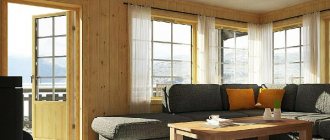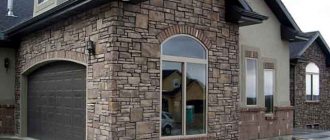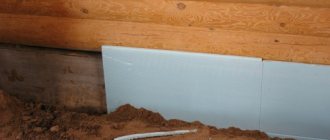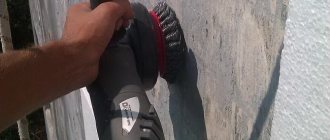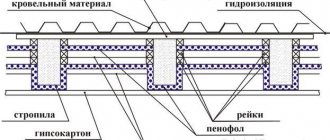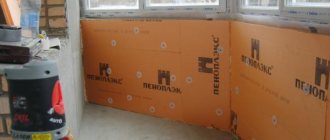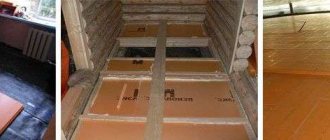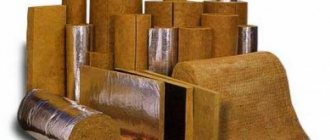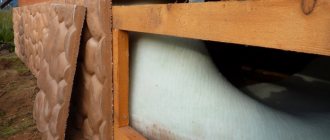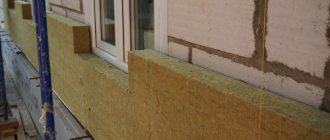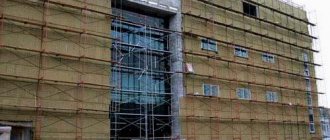Expanded polystyrene and its improved version of penoplex (extruded polystyrene foam) in some respects are widely used for insulation of both industrial facilities and residential buildings.
Any insulation has both advantages and disadvantages in the recommended areas of application. Experts say that expanded polystyrene had the lowest thermal conductivity before the appearance of penoplex, and other materials can achieve a similar indicator, but never exceed it. Polyfoam on a wooden house has a lower cost, but slightly worse performance.
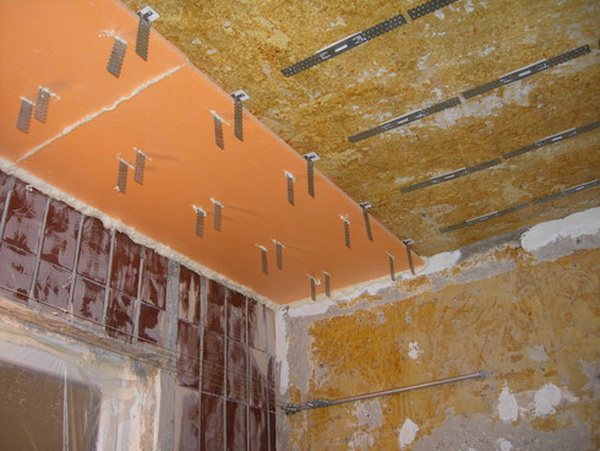
Material features
Penoplex is an extruded polystyrene foam. It is widely used to insulate walls, floors and foundations of various structures.
It can also be used to insulate wooden houses, summer cottages and other structures.
The material has a similar structure to foam, but they are produced using different technologies. Penoplex is manufactured using high temperatures and pressures.
Therefore, it turns out to be extremely light, but at the same time very durable. And the excellent thermal insulation characteristics are explained by the presence of air microgranules in the structure of the material.
Features of installation, advantages of penoplex
Before you buy expanded polystyrene, you should find out what its thermal conductivity coefficient is. The sheets must be placed close to each other, they must adhere to the wall and frame. To increase the thermal insulation of a house, it is necessary to insulate not only the walls, but also the foundation and the roof.
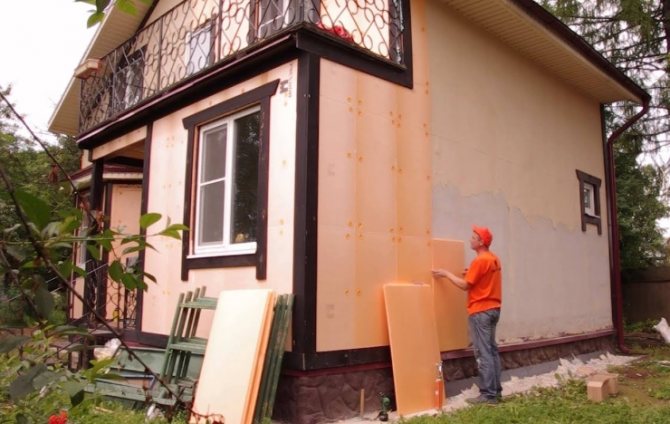

Penoplex is considered one of the best insulation materials for the facade, roof
Penoplex has many advantages over other materials. Among them it is worth highlighting:
- High quality.
- Strength. Resistant to precipitation and mechanical stress.
- Environmental friendliness. Does not contain substances that could be harmful to health.
- Resistant to temperature extremes. Retains properties at temperatures from -40 to + 70 degrees.
- Ease of installation.
- Durability. Does not rot and decay.
See the same: description of the properties of expanded polystyrene.
Despite the advantages, the material has a significant disadvantage - high cost. It is also flammable and has a low grip.
For those who decide to insulate the walls from the outside with penoplex, it is recommended to lay thick sheets. You can mount them in 2 layers, staggered. Thanks to this method, no gaps will be visible.
You can see the whole process of insulating the facade with penoplex in this video:
Insulation selection criteria
When choosing a material for insulating the floor and walls of a wooden house, one should take into account such indicators as cost, thermal insulation properties, ease of operation, strength and durability.
When evaluating these characteristics, one can answer the question of whether it is possible to insulate a wooden house with penoplex.
The main feature is its low price. It is almost three times lower than the cost of mineral wool.
At the same time, the thermal insulation characteristics of foam and mineral wool are practically the same. In addition, penoplex has a very low water absorption rate.
Installation of thermal insulation using foam is extremely simple. Therefore, it can be used for self-warming at home.
Its low weight allows even one person to work with it. And in order to cut into pieces of the required size, it is enough to use a clerical knife.
disadvantages
When choosing a penoplex for thermal insulation of a wooden house, one should also take into account the disadvantages of the material. The main one is flammability.
A wooden house itself is a fairly hot structure, and the use of materials with a low fire safety index only increases the likelihood of fire.
Another important disadvantage is the high vapor permeability. However, if a high-quality vapor barrier is carried out before the thermal insulation of the house, then this disadvantage can be ignored.
In addition, the foam that is used for insulation, as a rule, is treated with flame retardant compounds that prevent it from burning.
As a result, such material does not burn, but slowly melts, gradually fading out.
Vapor barrier
Before insulating a wooden house, it is necessary to make a high-quality vapor barrier. These manipulations are especially important for a house made of timber.
To perform vapor barrier, it is necessary to attach vertically to the walls wooden slats, the thickness of which must be at least 25 mm.
It is on them that vapor barrier materials will be attached using staples or nails.
After that, the attachment points should be protected with adhesive tape. These manipulations allow you to create ventilation between the walls and the thermal insulation material, as well as an optimal microclimate in the room.
Wall insulation technology
To create a warm and comfortable indoor climate, you can insulate a wooden house with penoplex.
Before insulation, you should prepare the work surface. First of all, it is leveled in such a way that no front more than 20 mm occurs.
A large knife should be used to cut the material into pieces of the desired size. It should be sharp enough so that the material does not crumble.
The resulting slabs can be laid end-to-end or overshoot. In the second option, gaps are formed between the plates, which should be filled with foam.
Before installing thermal insulation, a vapor barrier film should be installed, this is especially important when insulating a house from a bar.
If you do not put the film, then the wall will turn out to be breathable, but under the influence of moisture, the material will quickly become unusable.
Myth three: insulation disrupts natural ventilation
Despite the many advantages, penoplex, as an insulation material, also has a number of disadvantages. The main ones include the following. Firstly, penoplex is sensitive to the effects of organic solvents, which are often included in adhesive mixtures, so you need to carefully choose glue for penoplex and focus on specialized adhesive mixtures.
"We build from wood to live in an environmentally friendly atmosphere, and not breathe chemicals from your insulation!" - the reader probably thinks with indignation. Unaware that this is also a marketing myth. Of course, wood is a natural material. As well as brick and aerated concrete. Like basalt, from which mineral wool is produced, and oil is the mother of expanded polystyrene.
Wood today is not the same as a couple of centuries ago: its disadvantages, such as flammability, susceptibility to rotting and infestation by parasites, are compensated for by special chemical compounds with which each log is treated. Plus, the outer coating, which protects against rapid aging and preserves aesthetics (varnishes, paints, stains, etc.), does not add purity.
We invite you to familiarize yourself with Heliophytes have
If the house is made of laminated veneer lumber, it is worth remembering that the lamellas are held together with an adhesive. And in any will be interior decoration made of artificial materials, synthetics and chipboard furniture, plastic storage systems - in a word, modern utensils far from nature.Alas, if you are used to comfort, you will hardly find authentic pastoral to your liking.
Wood really "breathes". But she is not alone in this: aerated concrete, straw blocks with clay formwork, and the same brick and porous building blocks perfectly provide air exchange with the outside environment. But the throughput of natural ventilation is very low, and it is better, more precisely, it is necessary to think over a real, engineering air circulation system, not relying on nature and traditions.
Despite popular belief, experts say “breathing walls” is not an advantage, but a problem. They are constantly under the influence of moisture from the inside and outside, and with temperature changes it is fraught with getting wet, and freezing, and rotting. Therefore, it is better to take care of proper water and steam disposal and proper ventilation.
Insulation of the foundation
With the help of penoplex, you can also perform thermal insulation of the foundation of a wooden house. In this case, the plates should be installed from the inside to prevent the formation of condensation on the inner surface of the wall.
Thermal insulation of the foundation also allows you to create an optimal basement microclimate. In addition, the room will become much warmer, and heating costs will be reduced.
Video to help:
Additionally, you can make the floor insulation in a wooden house.
The modern building materials market offers a wide range of home insulation products. Among them, sheet organic insulation foam and expanded polystyrene are well-deserved attention and popularity. And if the first version of insulation has been familiar to us for a long time, then not everyone knows the second one.
What is Styrofoam?
Let's see what styrofoam is and how it differs from its distant cousin styrofoam.
Styrofoam - this is a whole group of polymeric materials, which are plastics, which are obtained by steam treatment of raw materials placed in a block mold. During this process, its molecules swell and fuse together. As a result, large micropores appear, which determine the high permeability of the material, low strength and fragility.
Expanded polystyrene is a type of foam. It is made by extrusion (it is also called penoplex), which leads to a completely different process flow and the final result. Unlike polystyrene foam, polystyrene foam has an integral microstructure. This means increased resistance, both to mechanical stress and to external factors.
Siding, its characteristics and types
Siding is called thin (from one to ten millimeters) type-setting panel parts for facing facades of buildings and other structures from two to six meters long. The width of the siding is from ten to thirty centimeters. This is not only a decorative coating. Siding panels in many cases are an important part of a multi-layer insulation wall covering. And also they are mounted to improve the hydrothermal insulation of the entire structure, to protect against external noise.
Siding is available in vinyl, wood, metal and cement. Metal panels are made of steel and aluminum with a width of twelve centimeters to fifty-five centimeters. The surface is made perforated or without holes. Curly or smooth-even. Wide smooth siding is in demand nowadays. They are versatile. They are mounted both vertically and horizontally. Metal siding is much more durable than vinyl siding, fireproof and does not require special maintenance. It is little affected by changes in ambient temperatures.
Wood siding are made by pressing wood fibers and binders under high temperature. During manufacture, paint is applied to the panel at a high temperature at five. The paint provides reliable protection.For environmental reasons, the production of wood panels does not use resins containing phenol-formaldehyde substances. In appearance, they are much more attractive than other types.
Cement Siding Panels made from cement mortar with the addition of cellulose. The surface is primed and painted. It is usually used for exterior decoration of buildings without a ventilated facade.
Vinyl siding - these are polyvinyl chloride one and a half millimeter panels with a length of 3.66 meters to 3.85 meters and a width of twenty to twenty-eight centimeters. Siding is made with imitation in one, two or three boards. And therefore they are called, respectively, single, double or triple. The outer side can be made as natural wood, or painted in a single color.
Vinyl panels are resistant to ultraviolet light and dyes. They do not absorb moisture, do not rot, do not grow moldy. Elastic, resilient, resistant to mechanical stress, shockproof. They are not toxic. Vinyl siding comes with accessories for corners, ceilings, cornices, windows and others.
Benefits of expanded polystyrene
We found out that expanded polystyrene is resistant to environmental factors and mechanical stress. But this is just one point from a wide range of benefits:
- Effective energy saving... Due to the structure of gas-filled cells, expanded polystyrene has low vapor permeability and thermal conductivity, and has excellent thermal insulation properties. According to statistics, the thermal insulation indicators of a layer 3 cm thick are equal to 123 cm of concrete, 64 cm of brickwork, 11 cm of wood or 6 cm of mineral wool.
- Durability... Studies carried out in Germany, the homeland of expanded polystyrene, have shown that the material with which the roof was insulated back in the 50th year did not change its insulating and other properties.
- Safety... The material is not a source of harmful dust and does not contain fibers. Therefore, it does not require special protective equipment (glasses, gloves) and is easy to process without causing irritation of the mucous membranes and other health problems. Even if a piece of expanded polystyrene is swallowed, there is no negative effect on health, and the material passes through the digestive tract without changes in its structure.
- Ease... The low weight of expanded polystyrene makes it the most economical and convenient material for insulation.
- Resistant to chemicals and biological influences... Expanded polystyrene is resistant to the influence of various chemicals, UF radiation and temperature changes. It is not susceptible to decomposition, washout and the development of mold. This material does not create a breeding ground for the vital activity of fungi and bacteria, and is also not assimilated by rodents and other animals.
- Eco-loyalty... Polyfoam is an environmentally friendly, non-toxic material. It does not contain astringents, does not emit formaldehyde resins, does not deplete the ozone layer and does not pollute the environment. Therefore, in addition to construction, it is used for the manufacture of toys for children, food packaging and the cultivation of greenhouse fruits. In addition, polystyrene foam is recyclable and 100% recyclable without damaging nature.
- Fire resistance... Expanded polystyrene is combustible. But if its cells are filled with carbon dioxide or other refractory components, the material does not ignite and prevents the flame from being thrown further.
- Moisture resistance... Expanded polystyrene is not affected by moisture, its absorbent and diffuse properties are practically zero, due to which it does not require additional waterproofing.
And here is an article about the insulation of a wooden house with mineral wool.
Insulate outside or inside the house?
Very often, the inhabitants are faced with the question of how best to insulate with penoplex: outside the house or inside.Let's try to reasonably analyze this problem.
- Firstly, with the internal insulation of premises, the sheets of foam will steal the free space of the rooms, thereby reducing their squaring.
- Secondly, the penoplex located inside the room will contribute to the deterioration of the microclimate in the rooms.
- Thirdly, due to the penoplex located inside the room, the mode of moisture and steam separation in the room will be disrupted. We will dwell on the latter in more detail, since it is this fact that scares many away from penoplex when choosing a heat-insulating material. Indeed, the accumulation of moisture due to the precipitation of condensate occurs when the foam sheets are placed inside the room. This is due to the difference between indoor and outdoor temperatures. Due to the flow of warm air from the inside of the room and the flow of cold air from the outer wall, condensation forms on the inner surface of the foam, which often causes the appearance of fungi and mold with all the ensuing consequences.
We suggest that you familiarize yourself with the Snowberry is it possible to eat berries
All of the above troubles can be avoided by insulating a wooden house with foam from the outside.
How to insulate a wooden house outside with penoplex with your own hands, read below.
- where to insulate - from the inside or outside?
- what material to choose?
- how to comply with the technology?
The easiest way to answer the first is unambiguously from the outside. The experts are unanimous on this. With internal insulation, the outer wall will be completely isolated from the home atmosphere with a layer of insulation and in winter it will cease to warm from the inside. Accordingly, after a while it will completely freeze out and begin to collapse. And another nuance - a decrease in the area of the room. Depending on the material, the loss can be substantial.
External insulation completely excludes such consequences. The main thing is to carefully choose and correctly mount the material.
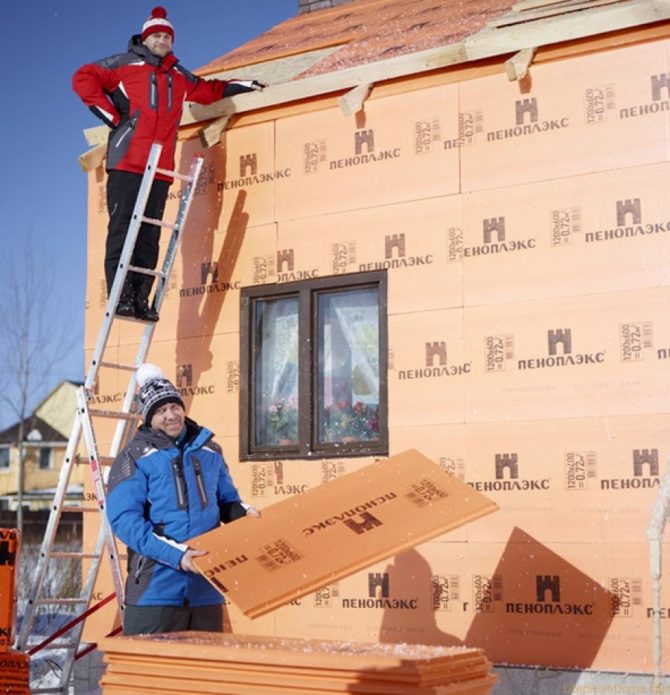

Depending on the chosen insulation, the design can vary from daunting to elementary simple.
There are not so many materials suitable for our task. Perhaps the great five looks like this:
- Mineral wool
- Ecowool
- Polyurethane foam
- Styrofoam
- PENOPLEX
A popular insulation today is mineral wool. It is a fibrous material that is produced from mineral rocks, mainly basalt. It is melted and soft bulk mats are collected from the threads formed. There is both a soft roll format and a hard slab format - it is suitable for vertical surfaces. Glass wool also belongs to the family of mineral wool.
The properties of different types of material may differ, but in principle they are all similar: in terms of the coefficient of thermal conductivity, and in terms of high hygroscopicity, and in terms of the tendency to deformation during operation.
Mineral wool insulation has its advantages: mats are non-toxic, keep warm well. But the installation is perhaps the most time consuming: it requires the construction of a multi-layer structure outside the load-bearing walls. The "pie" looks like this:
- Vapor barrier - a film or membrane that does not allow vapors from wood to enter the cotton wool.
- Lathing - a frame for installing mineral wool slabs.
- Thermal insulation - in fact, the insulation itself is at least two layers, laid in a checkerboard pattern to prevent blowing at the joints of the plates.
- Hydro-wind protection - a layer that protects cotton wool from atmospheric troubles in the form of rain, snow, wind.
- External lathing - for fixing the hydro-barrier and the facade.
- Facade finishing.
Not only the design itself is complex, each layer also has its own technological requirements. After all, stone wool loses to all its competitors in that it absorbs and accumulates moisture.If this is allowed, then the effect of insulation will be zero, and the material itself will soon collapse.
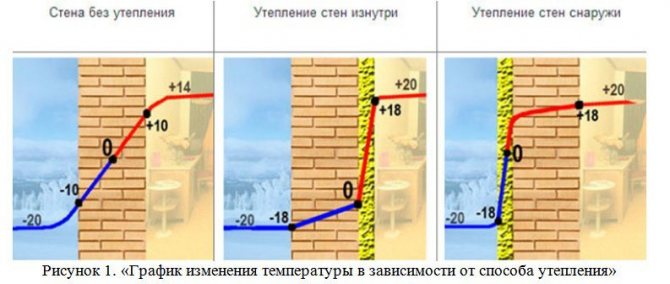

The consumption is also high, usually the slabs are laid in two layers to block potential cold bridges. Considering the cost of each of the components of the wall "pie", as well as the wool itself, the option is not cheap. And over time, the insulation will have to be replaced - it does not like the vertical position, it loses in volume, rolls down and in any case gets wet in places.
Ekovata is a relatively new player in the construction market.
Ecowool is a spray-on insulation made up of 80% recycled cellulose. Waste paper is used for its manufacture, which is crushed and processed with boric acid. It is considered the most environmentally friendly material.
Among the undoubted advantages are low thermal conductivity and seamless laying technology, which eliminates the occurrence of "cold bridges".
There are many times more cons:
- The material perfectly absorbs moisture and adsorbs vapors, therefore it needs ventilation.
- Already in the first year of operation, it loses up to 20% of its volume, and, consequently, heat-saving properties.
- When insulating walls that shrink (and in a situation with a tree this is a permanent process), non-insulated cavities are formed.
- Application is technologically difficult, you need special equipment and the help of a laying specialist. In the process of dry application, it is very dusty, and when wet, it dries for a long time.
Another type of sprayed insulation is liquid polyurethane foam.
Polyurethane foam is a type of plastic. After drying, it forms a durable layer with a cellular structure, due to which a heat-saving effect is provided. Polyurethane systems consist of two components: polyisocyanate (B) and polyol (A).
Polyisocyanate is a product of phosgenation of polyamines, which are formed during the condensation of aniline with formaldehyde in the presence of an acid catalyst. It contains 4,4-diphenyl-methane-diisocyanate (4,4-MDI) and its isomers, as well as oligomers with higher functionality. The product contains admixtures of small amounts of hydrochloric acid, other chlorinated acids and iron. The polyisocyanate is called crude MDI because contains non-distillable products.
Polyols (polyesters). Polyesters are sources of hydroxyl (-OH) groups, which form a polyurethane structure by reacting with an isocyanate. The choice of the structure of the starting polyol or its mixture determines the final properties of the polyurethane foam.
At the household level, polyurethane foam is familiar to everyone - as a polyurethane foam in cylinders. For wall insulation, it is chosen for covering ability, speed of application and drying, strength and moisture insulating properties. Another undoubted plus is excellent adhesion to most surfaces, even not too well prepared.
However, it never became a mass, "popular" heater:
- because of the cost - this material is 2-3 times more expensive than other heaters on the Russian market. Why pay extra for something that you can get much cheaper?
- due to the complexity of the technology - special equipment and skills are required. For example, in Europe, specialists in spraying such coatings are considered highly qualified;
- due to additional requirements for protection at the time of spraying and during the drying process. Craftsmen wear special suits and masks to protect themselves from harmful effects;
- due to the property of the material to collapse from excess moisture and sunlight.
The next item on our shortlist - polystyrene - has been used for a long time as a heater for wooden houses. There are several reasons:
- high thermal efficiency;
- low vapor permeability;
- easy installation;
- low price.
Let's make a reservation: in construction, foam is not the material that is used for packaging, but expanded polystyrene is more durable and durable.
Foam plastic is glued with a special compound to a cleaned wooden surface, fixed with dowels. If a "wet facade" is conceived according to the project, then a layer of foam plastic is reinforced with a fiberglass mesh and then plaster is applied. In all other cases, they simply mount the facade finish.
It is much easier to carry out such insulation with your own hands, however, there are also significant "buts" here:
- Polyfoam is a rather fragile material, it crumbles in the hands, and when cutting, pieces can break off, which does not contribute to a good joint of the plates. And this is guaranteed to lead to the formation of "cold bridges".
- Polyfoam is very fond of mice - they gnaw passages in it and build nests. Rodents can ruin the facade and expose the insulation, which will collapse in the light.
- The foam has an open cellular system, which allows it to become saturated with moisture over time and lose its heat-insulating properties.
We invite you to familiarize yourself with All about the grape variety Ksh red
Modern extruded polystyrene foam is much better in these parameters. In our country, the most popular brand is PENOPLEX, this name has long become a household name for this type of insulation.
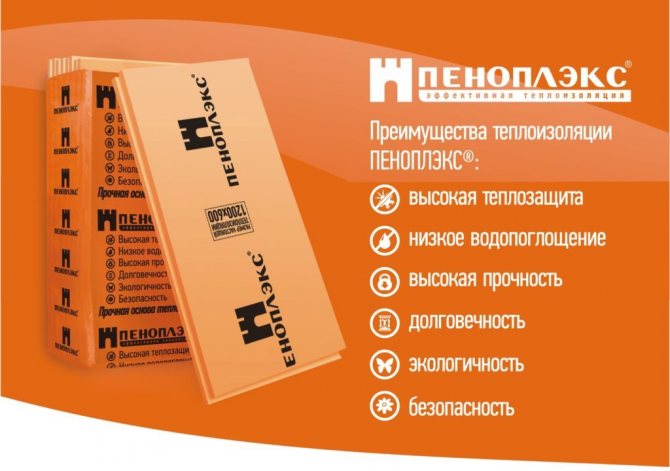

PENOPLEX is a material made from polystyrene granules by stirring at high temperature using a blowing agent, and then passed through an extruder. The result is a dense slab with a uniform cellular structure, and the cells are closed. That is why the thermal conductivity of PENOPLEX today is the lowest among all types of insulation.
Objective advantages of the material:
- low cost;
- light weight and small (up to 150 mm) slab thickness;
- maximum ease of installation and the impossibility of the formation of "cold bridges" due to the L-shaped edge around the perimeter of the slab;
- lowest thermal conductivity;
- almost absolute moisture resistance and low vapor permeability;
- resistance to compression and other mechanical stress;
- not interested in rodents;
- durability - without changing properties, it serves for more than 50 years.
PENOPLEX is now gaining more and more popularity, destroying perennial stereotypes. In particular, already voiced - "breathing walls". It is believed that the vapor permeability of the insulation should be comparable to that of the wall material. In fact, only one type meets this requirement - it is mineral wool, from which it is easy to draw a conclusion about the marketing origin of this myth.
Thermal insulation of a wooden house outside with penoplex
Often, wooden houses have good thermal insulation properties. therefore external insulation of a wooden house with expanded polystyrene is necessary if only:
- during long-term operation, the tree began to leak air;
- there was a violation of the caulked layer;
- blowing takes place with poor joints;
- moisture evaporated from the tree, and the logs began to crack.
Thermal insulation of a wooden house with expanded polystyrene takes place in four stages:
- Surface preparation.
- Installation of a vapor barrier.
- Insulation laying.
- Finishing work.
Preparation
Wood is a rather whimsical material. Therefore, before starting the installation of insulation, you need to properly prepare the surface.
Surface preparation for laying heat-insulating material consists in:
- Removing old paint.
- Drying the walls.
- Checking the joints between the beams / logs.
- Re-caulking the walls (if necessary).
- Potting up potholes.
- Sawing off protruding parts.
- Processing and impregnation of wood with special substances.
Installation of a vapor barrier
To avoid condensation at the point of contact between wood and expanded polystyrene, a vapor barrier is laid between them. You can get the relevant materials and advice on their use in any building supermarket.
Insulation laying
If the installation of expanded polystyrene is carried out on a vapor barrier, it is fixed with a special glue or mixture. The adhesive is applied to the board with an 8 mm notched trowel. It is necessary to glue polystyrene foam quickly, since the adhesive properties of the mixtures last no longer than 10 minutes. The laid slabs are fixed with plastic dowels, five for each: four dowels at the edges and one in the center.
On top of the laid polystyrene foam, a second layer of the vapor barrier is applied.
And here is an article about house insulation with polystyrene foam.
In this section of our website https://ru-house.net/sistemy/uteplenie/ everything is the most important and necessary for insulating your home.
Finishing work
Insulation cladding is performed with clapboard, siding or plastering materials.
Expanded polystyrene Is an excellent thermal insulation material with a lot of advantages, including durability, resistance to various external factors and eco-loyalty. Low vapor permeability of expanded polystyrene can create some difficulties for insulating the facade of a wooden house with it.
A wooden house needs insulation, like any other structure, although wood itself is a good heat insulator. The outer cladding also has a protective function. The base made of wood, lined with an insulating layer, will last a longer period.
In any building, walls need insulation most of all. Heat loss of wall surfaces can be up to 30%. It is possible to place the heat-insulating layer on the walls both inside and outside the room. But preference is given to external insulation with penoplex.
Insulation technology using foam
The thermal insulation algorithm using extruded polystyrene foam is extremely simple and, following the rules, you can quickly and efficiently insulate the facade with your own hands.
Surface preparation
To ensure strong adhesion of the insulation to the surface, it should be carefully prepared. Work should include not only tidying up the wall itself, but also correcting ebb tides, window sills and other protruding elements.
Preparatory procedures before insulation:
- Facade cleaning. It is necessary to remove the old layer of finishing (plaster, paint), dust, dirt and all kinds of stains that can affect the degree of adhesion.
- If there is mold or mildew on the surface, they must be removed and the wall treated with a special antiseptic.
- Metal elements on the facade must be opened with an anti-corrosion agent.
- Check the evenness of the wall. Small deviations are allowed, but if there are irregularities of more than 2 cm per 3 m², then alignment will be required.
- After preparation, the surface is covered with a primer, which should be selected taking into account the characteristics of the facade material. This will make it possible to ensure maximum adhesion of the insulation and the wall.
In situations where surface alignment is required, there are several options for solving the problem:
- Plastering. An additional layer of plaster will help to achieve perfect evenness without affecting the properties of the insulation.
- Use of slabs of various thicknesses. In this case, the thermal insulation of individual areas will be different.
- Application of special leveling pads. This procedure is considered quite time consuming and requires certain skills.
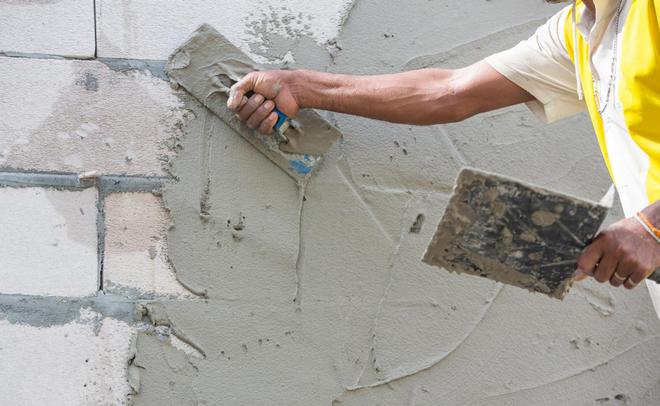

Leveling the walls before further thermal insulation
Having prepared the wall, you can proceed to the installation of foam insulation boards.
Fastening the penoplex
The procedure includes two stages: gluing the boards and their further fixation with hardware.
Before fixing the slabs, it is necessary to install a basement profile around the entire perimeter of the insulated surface. It should be level, so after attaching each element with dowel-nails, you should use a level.It is from the basement profile that the penoplex will be glued.
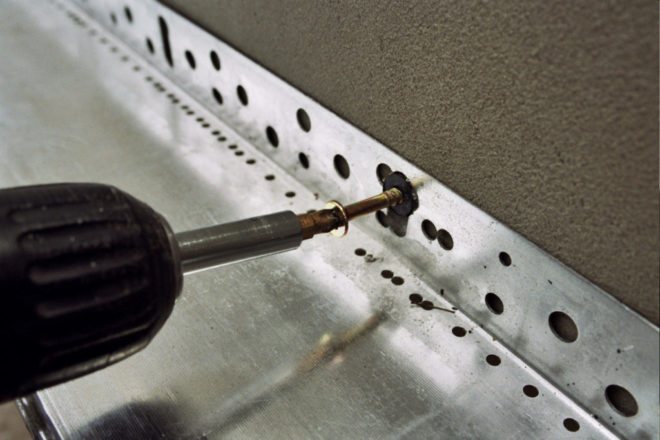

Plinth profile installation
Certain requirements are imposed on its installation:
- the thickness of the basement profile should be similar to the thickness of the insulation;
- work should be done carefully so as not to damage the profile;
- to achieve a snug fit, it is recommended to use washers;
- the profile should be installed with a minimum clearance for thermal expansion, not overlapping;
- it is better to purchase a profile with a drip to drain moisture;
- at the corners, the elements are fixed at an angle of 45 °, and for window and door openings, special adjoining parts are used.
After preparing the basement profile, it is necessary to cut the penoplex. It is important that all elements are prepared in advance. The material is flexible in processing, so trimming is very easy. The glue mixture is prepared immediately before gluing, as its quality deteriorates over time. When purchasing glue, it is worth considering the type of surface and the conditions in which the insulation will be carried out: temperature, climatic features, etc.
Facade installation starts from the bottom corner.
The adhesive solution should not be applied over the entire surface of the board, but around the perimeter and center.
If there are recesses on the surface of the facade, then more glue should be applied to the place of contact between the foam and the wall.
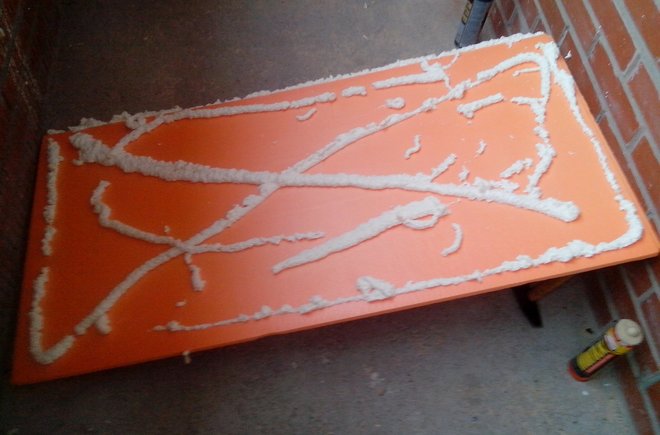

Applying glue to the material
Plates must be placed tightly to each other. If gaps are formed, then they should be additionally processed to prevent the formation of cold bridges. This can be done with foam, the excess of which is subsequently trimmed off with an assembly knife. To achieve the maximum effect of insulation, it is recommended to install the foam in several layers. In this case, the slabs on the facade are staggered. For insulation of windows and doors, you can use foam plates of lesser thickness.
The second stage is fixing the foam with disc dowels. This will ensure reliable adhesion to the surface, and therefore an ideal insulation effect.
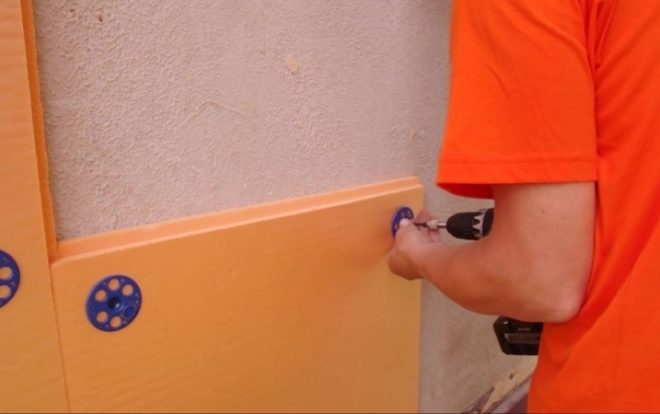

For reliability, use disc dowels
Fastening is necessary only after the glue has completely solidified. This period depends on the mixture used. It is best to carry out these works three days after gluing.
Reinforcement
The procedure is carried out for reliable adhesion of the plaster layer, which performs a protective function. First of all, you need to prepare a plastering solution. It should be slightly watery.
The mixture is applied to the surface of the facade and a fiberglass mesh is applied on top, which must be drowned in the solution.
The edges do not need to be fixed, they must be free. In this way, all sections of the reinforcing mesh are attached.
After the mixture is completely dry, it is necessary to wipe the surface. Another layer of plaster is applied to the flat wall. It will be final before decorative finishing. This layer must also be wiped off so that the facade is even, without roughness. If it is necessary to ensure maximum adhesion, then before reinforcement, you need to wipe the penoplex so that the plates become rough, and then cover them with a primer.
Before reinforcement, plaster corners can be glued to the corners of the building, this will help increase resistance to mechanical damage. Reinforcement should start with openings. First, windows and doors are processed, only then it is worth moving on to the rest of the facade surface.
Decorative finishing
Finishing should be started only after the previous layer has hardened. Most often, decorative plaster is used, on top of which paint is applied. Before plastering, a primer should be applied to the surface. It is important to keep an even layer, to avoid gaps. Once the surface is dry, decorative plaster can be applied.This must be done in a thin layer. Dilute the solution exactly as recommended by the manufacturer.
To give the surface a certain pattern, bevel is used. With progressive or circular movements, you will be able to create the type of surface you want. The entire wall must be plastered in one go. If you do this in several passes, then the joints can stand out noticeably, which will worsen the external result of the facade insulation.
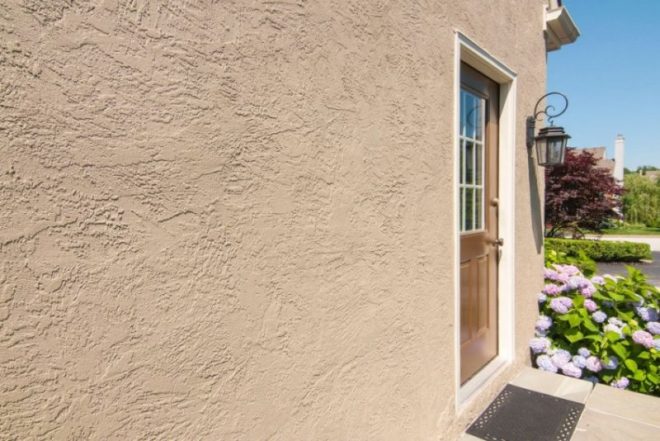

Facade decorative plaster
The final stage of insulation is painting the facade. The paint should be purchased of high quality so that it does not deteriorate under the influence of atmospheric factors. It is necessary to apply a layer of paint thinly, therefore it is better to use a roller. With its help, it will be possible to make the coloring of the facade uniform. To enhance the final result after the first layer has dried, you will need to repeat the procedure.
With the help of penoplex, you can create excellent thermal insulation. Insulating the facade with this material is a fairly simple process. If you strictly follow these recommendations, then a comfortable atmosphere in the house and an attractive appearance of the building are guaranteed.
Benefits
If you place the thermal insulation layer inside the house, the dew point will shift. This indicator determines the temperature value below which condensation occurs. The dew point in this case moves inside the room. This means that the humidity will increase, the walls will start to "sweat" and mold will form. Internal insulation reduces the space of the room.


Even a small thickness of insulation can significantly reduce the squaring, because for the thermal insulation of a wooden building, you will need to arrange the lathing. Another factor is the deterioration of the internal microclimate. The use of even modern heat-insulating materials will not allow the wood to "breathe". Outside insulation eliminates all of the above.
Material selection
Before you start insulating work with your own hands, you need to choose the right insulator. The choice is based on three main indicators:
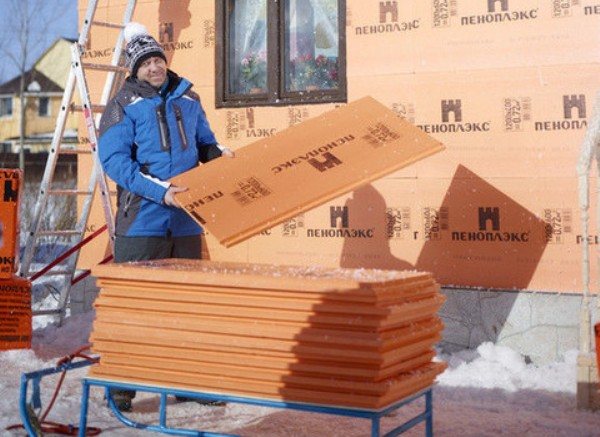

The cost of the material also affects the choice, but it is not always indicative. More expensive insulation can be more effective and more durable.
Density
For work on a wooden building, a heat insulator is suitable, which has a density value of 25 kg / m³. With an increase in density, the strength of the material also improves. But the main indicator is still thermal conductivity. With an increase in density, the thermal insulation qualities of the material will decrease.
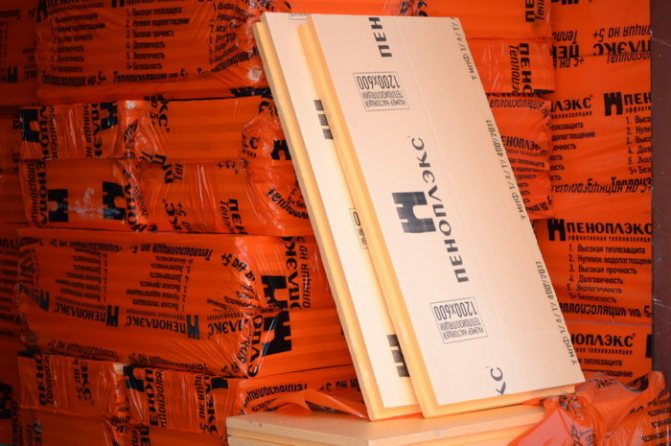

The thickness is calculated depending on the location of the house and climatic conditions. To clarify this indicator, it is better to contact sales consultants. Consider the advantages of using and equipment for insulating a wooden building with penoplex.
Required thickness parameter
To insulate a house outside with penoplex with your own hands, you need to choose the appropriate thickness of the product. Here you should pay attention to the climatic zone. When buying a penoplex, insulation is carried out taking into account the fact that the insulating cake must provide a total heat transfer resistance not less than that established in building codes.
For the calculation, the thermal conductivity coefficient of the insulation is additionally required. To find out the thickness of the foam, you can use the following formula: P (thickness, m) = R (heat transfer resistance, which can be taken from the official SNiP sources) * k (thermal conductivity index).
Penoplex characteristics
This name has extruded polystyrene foam. It is the most productive heat insulator due to its qualities:
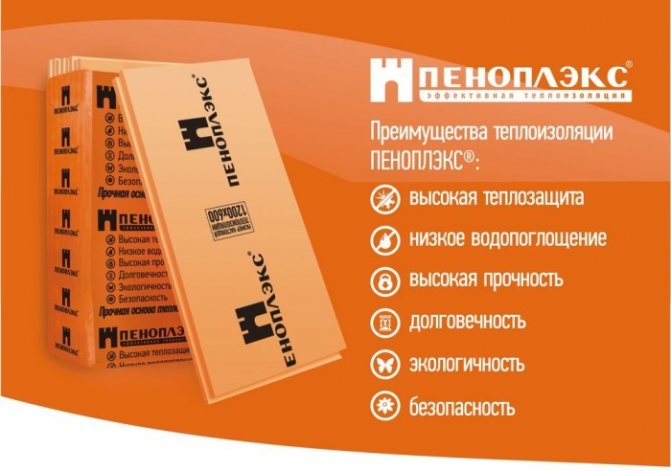

- low moisture absorption, its cellular structure practically does not absorb water;
- high thermal efficiency allows using a smaller thickness of the insulating layer;
- fire safety, polystyrene foam does not burn and does not emit toxic substances;
- ease of installation;
- good strength and resistance to mechanical stress;
- resistance to the formation of fungi and mold.
Types of extruded polystyrene foam
Penoplex can have different density, its value is in the range of 25.0–45.0 kg / m³. Depending on this indicator, the material has a different purpose and is divided into five types:
- the first - for the roof (28.0–33.0 kg / m³);
- the second - for the foundation (29 kg / m³);
- the third is for walls (25 kg / m³);
- the fourth is universal (25.0–35.0 kg / m³);
- the fifth is industrial (45.0 kg / m³).
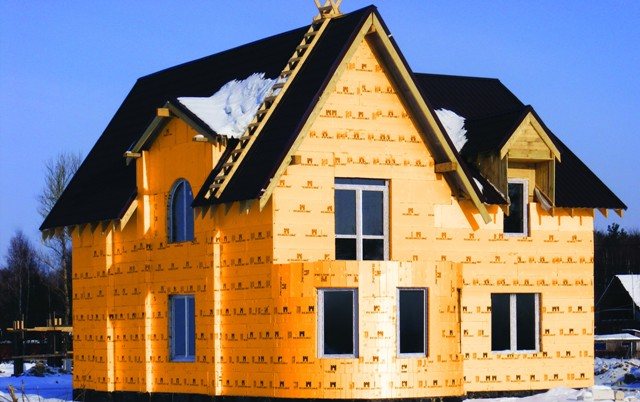

Each of them has its own purpose depending on the name. The universal version has collected all the best indicators, therefore it can be applied to any part of a wooden building.
Industrial penoplex has the highest strength. It is used for road construction and insulation of industrial pipelines.
The main types of insulation for walls
Nowadays, as the main insulation for the walls of the house outside for siding the following materials are used:
- Polyfoam (expanded polystyrene), polystyrene foam, polyurethane foam.
- Mineral wool.
- Basalt insulation.
The thermal conductivity of each insulation material can be clearly seen using the following comparative table. A standard 90 cm thick brickwork is taken as a starting material for comparison.
| No. of pp | Wall materials | Brickwork 90 cm thick (cm) |
| 1 | Concrete | 213,2 |
| 2 | Pine wood | 34,0 |
| 3 | Mineral wool | 12,5 |
| 4 | Styrofoam | 7,5 |
| 5 | Penoizol | 5,0 |
Styrofoam (expanded polystyrene)
It is a modern insulation for walls and other surfaces.... It is used in all areas of industrial and civil construction. It has a low coefficient of thermal conductivity. Resistant to chemical and biological influences, has high sound insulation. Durable and environmentally friendly material with a service life of more than fifty years.
Another advantage of foam sheets is their low weight and low price. The weight contributes to the low labor intensity of the work performed, does not load the walls, which removes the need for additional strengthening of the foundation. The disadvantage of this material is flammability.
Extruded polystyrene foam (penoplex)
The latest generation of thermal insulation material based on graphite nanoparticles. Penoplex thermal conductivity coefficient is 0.03 W / m * K... Very resistant to mold, chemicals, insects and rodents. Excellent sound insulator. In addition to insulating the walls of buildings, it is used in the manufacture of the foundation of individual low-rise buildings using the "insulated Swedish plate" technology. It is used for protective sheathing of loggias and balconies, basement walls.
Polyurethane foam
Foam honeycomb plastic... The proportion of air-filled cells in polyurethane foam reaches 90 percent of the total weight of the insulation. Because of this, its thermal conductivity is one of the lowest. Differs in good adhesion to all surface materials: wood, concrete, metal and brick.
This creates an airtight coating with good water vapor barrier.
It is applied to the surface under pressure using a hose and a compressor. When blowing in, the plastic mass fills all cavities and cracks. The disadvantage of this insulating material is the high cost and the need for expensive equipment.
Mineral wool
This is a basalt insulation, glass wool, stone wool... A product of metallurgical waste and processing of rocks, such as dolomite and basalt. Differs in durability, non-flammability, environmental friendliness, strength, elasticity. Low price and ease of installation. It absorbs sound well. You can install cotton wool at any time of the year. When insulating walls outside with mineral wool for siding, it does not require special skill.
The industry produces this insulation in rolls and in the form of plates.Roll insulation is used to cover horizontal surfaces or surfaces with a slight slope. It is more convenient to insulate vertical walls with plates. Mineral wool can be used in conjunction with blown polyurethane foam. Rolls and slabs are produced in the following sizes:
| No. of pp | Length (cm) | Width (cm) | Thickness (cm) |
| 1 | 100 | 60 | 5 |
| 2 | 700 | 120 | 5 |
| 3 | 900 | 120 | 5 |
| 4 | 1000 | 120 | 5 |
| 5 | 1000 | 120 | 10 |
Liquid insulation
This is a new generation of heaters... Liquid insulating materials are now used to insulate metal pipes, foam block houses and other structures. It is a multicomponent ceramic substance similar to acrylic paint. It only contains up to 80 percent of voids in its sticky mass.
It is applied to the insulated surface with an ordinary paint brush, roller or spray gun. When applied with a spray gun, it fills all gaps and voids. After drying (at least six hours), it is resistant to mechanical stress, protects structures from precipitation and the sun, metal from corrosion.
External thermal insulation
Do-it-yourself wall insulation can be broken down into five main stages:
- preparation of walls;
- sheathing with vapor barrier;
- arrangement of the lathing;
- installation of penoplex;
- home decoration.
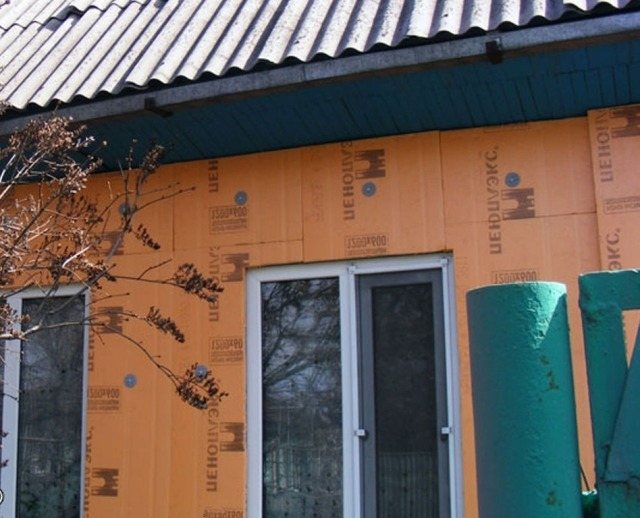

Before starting work, you need to check the foundation. The base for the thermal insulation device must be reliable.
Preparing the walls
The tree must be dry. If there is paint on the surface, it must be removed. The joints between the bars are also checked. They should be caulked along their entire length.
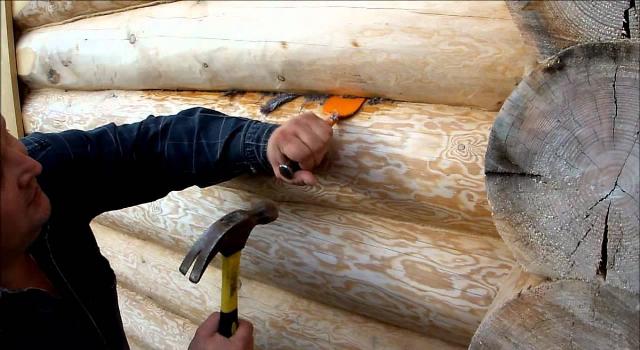

If there are protruding parts outside, they must be cut off. The last step in surface preparation should be the processing of wood with special impregnations.
Sheathing with vapor barrier
Around the entire perimeter of the walls, wooden slats with a thickness of 25–30 mm are stuffed. The step between them should be no more than 1 meter. A vapor barrier is laid on the slats and fixed with nails or a stapler.
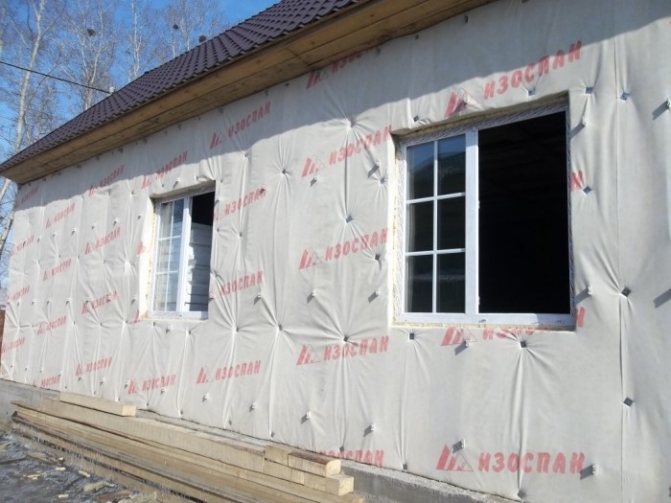

Due to the stuffed slats between the logs and the vapor barrier material, a ventilation gap is formed.
Arrangement of the lathing
It must be made of 25 × 50, 50 × 50 bars or metal profiles. The arrangement of the lathing is necessary for the installation of heat-insulating material. The step between the stuffed beams is selected according to the width of the insulation sheets.


In order for the penoplex to be firmly installed in the formed openings, the size between the bars should be 5 cm smaller.
Penoplex installation
A heat insulator is placed in the openings between the guides. If the outside uses two heat-insulating layers for insulation, then the insulator can be laid in two ways:
- sheets of two layers are arranged with an offset to avoid cold bridges;
- arrangement of two layers is carried out in perpendicular directions.
Consider the second option for DIY styling in more detail. The crate is first stuffed onto the vapor barrier in a horizontal direction and the first layer of foam is laid in it. Then, on top of it, the arrangement of vertical bars for the second row of thermal insulation is carried out perpendicularly.
Insulation of walls outside with mineral wool for siding
Mineral wool is an excellent option for wall insulation of buildings of any type. The owner of an individual house can do these works with his own hands without the help of professionals.
Wall insulation works with mineral wool include the following stages. First, the entire surface of the walls is cleaned. Antiseptic work is in progress. If the walls are wooden, then the surface is treated with a refractory primer.
Sheathing in progress from metal profiles or wooden bars. The crate is fixed to the wall with dowels. Additional lathing elements are attached near doors and windows. The pitch of profiles or bars usually does not exceed sixty centimeters. Mineral wool slabs should sit very tightly in the crate.
A hydro-windproof membrane is applied over the heat insulator.For the device of a gap for ventilation, the membrane is fastened with a counter-lattice made of bars three centimeters thick. Siding panels are mounted on them.

